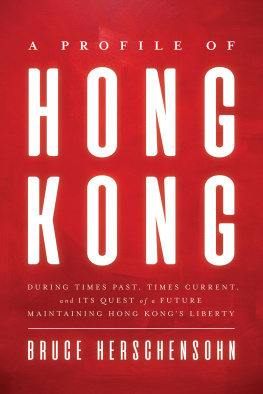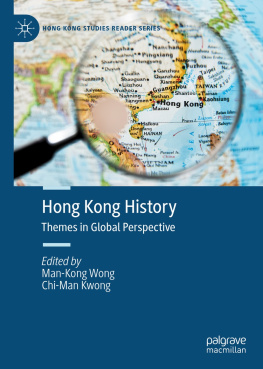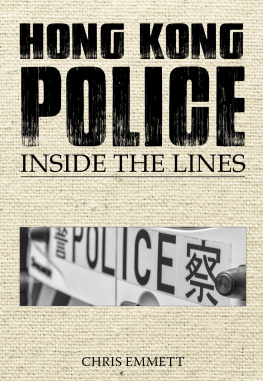Making Critical Sense of Immigrant Experience
A Case Study of Hong Kong Chinese in Canada
CRITICAL MANAGEMENT STUDIES
Series Editor: Albert J. Mills
Making Critical Sense of Immigrant Experience
A Case Study of Hong Kong Chinese in Canada
By
Rosalie K. S. Hilde
Port Coquitlam, Canada
United Kingdom North America Japan India Malaysia China
Emerald Publishing Limited
Howard House, Wagon Lane, Bingley BD16 1WA, UK
First edition 2018
Copyright 2018 Emerald Publishing Limited
Reprints and permissions service
Contact:
No part of this book may be reproduced, stored in a retrieval system, transmitted in any form or by any means electronic, mechanical, photocopying, recording or otherwise without either the prior written permission of the publisher or a licence permitting restricted copying issued in the UK by The Copyright Licensing Agency and in the USA by The Copyright Clearance Center. Any opinions expressed in the chapters are those of the authors. Whilst Emerald makes every effort to ensure the quality and accuracy of its content, Emerald makes no representation implied or otherwise, as to the chapters suitability and application and disclaims any warranties, express or implied, to their use.
British Library Cataloguing in Publication Data
A catalogue record for this book is available from the British Library
ISBN: 978-1-78743-663-3 (Print)
ISBN: 978-1-78743-662-6 (Online)
ISBN: 978-1-78743-674-9 (Epub)
ISSN: 2059-6561 (Series)
Contents
List of Tables
List of Figures
About the Book
Preface
Introduction
List of Tables
List of Figures
About the Book
T his book showcases a critical sense-making study of how professional immigrants from Hong Kong to Canada make sense of their workplace experiences, and what this can tell us about why a substantial number leave in their first year in Canada. Data show that informants have accepted unchallenged assumptions: (1) that the government is providing help for them to get in to the workplace; and (2) that the ethnic service organizations are offering positive guidance to their workplace opportunities. At the organizational level, a master discourse emphasizing integration has mediated immigrants struggles. Within these frustrations, many have internalized a hidden discourse of inadequate or deficient selves and adopted a sacrificial position to maintain a positive sense of identity.
Racism exists at both the systemic and personal level for professional immigrants moving from Hong Kong to Canada. However, many immigrants are unaware of the ways their assumptions may be informed by racism; hence, they may accept unequal practices as normal. Although contextual elements are powerful, some immigrants have developed strategies at the micro-level to resist.
The study concludes that a critical sense-making approach allows a greater insight into immigration processes than realist surveys, which tend to impose a pre-packaged sense of the immigrant experience. Through critical sense-making, readers are encouraged to rethink the current role of ethnic service organizations in the immigration system.
Preface
T he motivation for this book is twofold. First, this book is intended to give voice to immigrants. The second motivation lies in my own frustrating experience as a doctoral student when the research method that I wanted to use was supported by few publications in the scholarly literature. Even where I found those publications helpful, the methodological details were usually too concise (due to the limitations on length in a journal article) and thus it was difficult to figure out how Critical Sensemaking worked in practice.
This book was written to fill this gap in the literature. I have written with a broad audience in mind: doctoral or graduate students who are searching a methodology to fit their philosophical positions; academics who are updating their course readings in qualitative research method courses even if they do not intend to use such methods themselves (Chapters 14 and the Epilogue); seasoned researchers who are turning to Critical Sensemaking to complement other modes of inquiry; practitioners who are interested in hearing the voices and reflections of immigrants and potentially rethinking their current roles in the immigration system (Chapters 58); and finally policy makers who want to gain an in-depth understanding and create sustainable solutions that realist survey methods cannot offer (Chapters 58). Additionally, this book may be of interest to scholars in diversity management, identity work, and social studies.
Like all academic work, this book only exists because of the help and creative insights of many people. The first and most important acknowledgment is to Dr. Albert J. Mills of Saint Marys University, the series editor, who has dedicated years of commitment to critical scholarship and has encouraged me to publish this book. I would also like to thank the Emerald publisher, John Stuart, and the four anonymous reviewers for their time and effort in reading and commenting on the book proposal. Their invaluable feedback has strengthened the frame of the book.
I am also grateful for the support of Douglas College, Thompson Rivers University, and Athabasca University, which made writing of this book possible. My thanks also go to my husband Rod, my daughter C.Y., and my sons Jonathan and Nathan, who have supported, trusted, and loved me every day. It would not be possible without all of you! Not least, my best friend Emily and also to my sisters Lizzy and Gemini.
Introduction
I n this latest book in the Critical Management Studies series, Rosalie Hilde contributes to our understanding of the interplay between the individual, the structures, and the discourses that serve to construct a sense of the immigrant.
Drawing on and developing the method of Critical Sensemaking (CSM), Hilde explores the hitherto neglected experiences of the individual immigrant. In particular, she is interested in exploring the sensemaking processes of people who immigrate to a culturally different country in this case, Hong Kong Chinese immigrants to Canada.
As a Hong Kong Chinese immigrant herself, Rosalie Hilde reveals her interests and concerns about a community in Canada that has experienced a high rate of attrition, with large numbers returning to Hong Kong a short time after their initial experiences of being in Canada. One of her concerns is to bring to the surface the hitherto neglected voices of the immigrant while, at the same time, provide understanding of the influences on the sense of the immigrant experience.
Through Critical Sensemaking Rosalie Hilde sets out to develop a method for understanding the relationship between the cognitive, structural, discursive, and formative contexts in which sensemaking occurs. In so doing, she shows us the strengths and challenges of applying CSM in making sense of the immigrant experience. Along the way, she takes us to a world of challenges, stresses, discouragement but also optimism as she talks to immigrants about their various experiences, ways of making sense of those experiences, and the contextual influences involved. The result is a complex series of insights that provide a novel understanding of the immigrant experience of non-Western immigrants to Canada.











